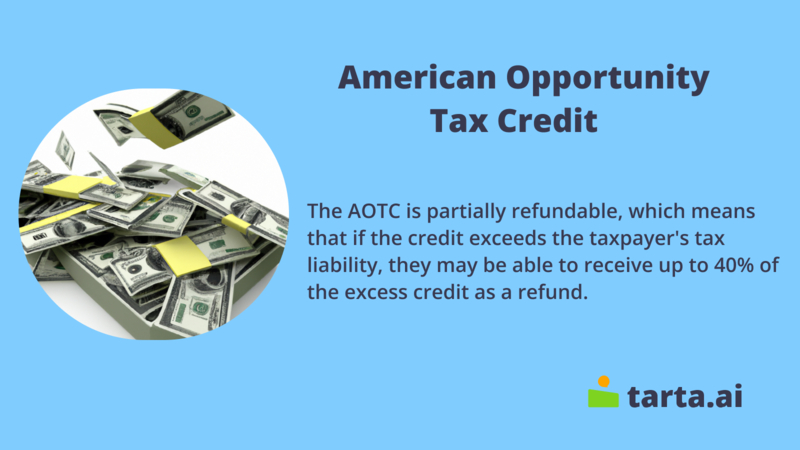What Benefits Can You Get From American Opportunity Tax Credit?
What is American Opportunity Tax Credit (AOTC)?
The American Opportunity Tax Credit (AOTC) is a tax credit available to eligible students and their families to help offset the cost of college tuition and related expenses. The AOTC was introduced as part of the American Recovery and Reinvestment Act of 2009 and was originally set to expire at the end of 2012, but has since been extended several times. The credit can be claimed for up to four years of undergraduate education and provides a tax credit of up to $2,500 per eligible student.
FACT
In 2019, 9.3 million taxpayers claimed the AOTC credit, according to the IRS.
Requirements and Limitations of the AOTC
The American Opportunity Tax Credit (AOTC) is a tax credit available to eligible taxpayers who pay qualified education expenses for themselves, their spouse, or their dependents. This credit can help offset the costs of higher education and provide financial relief to those who qualify. However, there are specific requirements and limitations that taxpayers need to be aware of when claiming the AOTC. In this article, we will delve into the details of the AOTC to help taxpayers understand if they are eligible and how to claim this tax credit.
The AOTC has several requirements and limitations that must be met in order to be eligible for the credit:
- Enrollment status: The student must be enrolled at least half-time in a program that leads to a degree, certificate, or other recognized educational credential for at least one academic period during the tax year.
- Eligible expenses: The credit can only be claimed for qualified education expenses, which include tuition, fees, and course materials required for the student's enrollment or attendance.
- Maximum credit amount: The maximum credit amount is $2,500 per eligible student for each of the first four years of college. The credit is calculated as 100% of the first $2,000 in qualified education expenses, plus 25% of the next $2,000 in qualified education expenses.
- Income limits: The AOTC has income limits for eligibility. For the tax year 2021, the credit begins to phase out for single filers with a modified adjusted gross income (MAGI) of $80,000 or more, and for married filing jointly filers with a MAGI of $160,000 or more. The credit is completely phased out for single filers with a MAGI of $90,000 or more, and for married filing jointly filers with a MAGI of $180,000 or more.
- Nonrefundable credit: The AOTC is a nonrefundable credit, which means that it can only be used to offset any tax liability owed by the taxpayer. If the credit exceeds the taxpayer's tax liability, the excess credit cannot be refunded to the taxpayer.
NOTE
The AOTC cannot be claimed for the same expenses that are used to claim other education tax credits or deductions, such as the Lifetime Learning Credit or the tuition and fees deduction. Additionally, the AOTC cannot be claimed for expenses that were paid with tax-free funds such as scholarships, grants, or employer-provided educational assistance.

Documents Needed to Claim the AOTC
To claim the American Opportunity Tax Credit (AOTC), eligible taxpayers must complete IRS Form 8863, Education Credits, and attach it to their federal tax return. The form requires taxpayers to provide information about the qualified education expenses they paid during the tax year, as well as the educational institution and the student for whom the expenses were paid.
Taxpayers should also keep records of their qualified education expenses, such as tuition, fees, and textbooks, as well as any scholarships or grants they received to pay for these expenses. This documentation may be needed to substantiate the claim for the AOTC if the IRS requests it.
NOTE
Only eligible educational institutions can be used to claim the AOTC. These institutions include colleges, universities, and vocational schools that participate in the federal student aid program. Taxpayers should ensure that they have the correct information about the institution and the student when claiming the AOTC.
Overall, taxpayers should carefully review the requirements and documentation needed to claim the AOTC and consult with a tax professional if they have any questions or concerns.
Comparisons between the AOTC and other Education-Related Tax Credits or Deductions.
The American Opportunity Tax Credit (AOTC) is one of several education-related tax benefits available to taxpayers in the United States. Other options include the Lifetime Learning Credit, the Tuition and Fees Deduction, and the Student Loan Interest Deduction. Each option has its own set of eligibility criteria, limitations, and benefits. It's important for taxpayers to compare these options and determine which one best fits their individual needs and circumstances. In particular, the AOTC offers a higher maximum credit and is available for a longer period of time than the other options, making it a popular choice for many taxpayers. However, the AOTC also has stricter eligibility requirements and income limits, so not all taxpayers will qualify.
Potential Changes or Updates to the AOTC and How They Could Affect Taxpayers
There have been several proposed changes and updates to the AOTC in recent years. For example, some policymakers have suggested increasing the maximum credit amount or expanding eligibility to include part-time students and graduate students. Additionally, there have been discussions about making the credit refundable, which would allow taxpayers to receive the full credit amount even if they don't owe any taxes. Any changes or updates to the AOTC could have significant impacts on taxpayers and their ability to afford higher education. It's important for taxpayers to stay informed about any potential changes and how they could affect their eligibility for the credit.
FACT
According to the IRS, taxpayers claimed over $18 billion in AOTC credits in 2019.

PICTURE: ISTOCK
Tips for Maximizing the Benefit of the AOTC and Avoiding Common Mistakes When Claiming It
Here are some tips for maximizing the benefit of the AOTC and avoiding common mistakes when claiming it:
- Understand the eligibility requirements: Make sure you or your dependent meet all of the eligibility requirements for the AOTC before claiming it on your tax return.
- Keep accurate records: Keep all receipts and documentation related to your education expenses, including tuition, fees, and textbooks. This will help you accurately calculate the amount of the credit you can claim.
- Don't claim expenses covered by other sources: You can only claim expenses that were not covered by scholarships, grants, or other sources of tax-free educational assistance.
- Coordinate with other tax breaks: If you're eligible for other education-related tax breaks, such as the Lifetime Learning Credit or tuition and fees deduction, compare the benefits and choose the one that provides the greatest tax savings.
- Seek professional advice: If you have questions or concerns about claiming the AOTC, consider seeking advice from a qualified tax professional. They can help you understand the rules and make sure you're maximizing your tax savings while staying compliant with tax laws.
- The American Opportunity Tax Credit (AOTC) is a tax credit available to eligible students and their families to help cover the cost of higher education expenses.
- The AOTC provides up to $2,500 in tax credits per student per year for up to four years of college education.
- To be eligible for the AOTC, the student must be enrolled in a qualified educational institution, pursuing a degree or other recognized credential, and meet income and other eligibility requirements.
- Documentation such as tuition statements, student loan interest statements, and 1098-T forms may be required to claim the AOTC.
- Taxpayers should be aware of the differences between the AOTC and other education-related tax credits or deductions, such as the Lifetime Learning Credit and the Tuition and Fees Deduction.
- As with any tax credit, it is important to understand the requirements and limitations of the AOTC to maximize its benefits and avoid common mistakes when claiming it.
FAQ
Who is eligible for the American Opportunity Tax Credit?
Students who are enrolled at least half-time in a degree or certificate program and have not completed four years of higher education are eligible, as well as their parents, if they claim the student as a dependent on their tax return.
What is the maximum amount of the American Opportunity Tax Credit?
The maximum amount of the credit is $2,500 per eligible student, and it is based on 100% of the first $2,000 of qualified education expenses and 25% of the next $2,000.
What expenses qualify for the American Opportunity Tax Credit?
Qualified education expenses include tuition, fees, and course materials that are required for enrollment or attendance at an eligible educational institution. Room and board expenses do not qualify.
Can the American Opportunity Tax Credit be claimed for multiple students in the same tax year?
Yes, the credit can be claimed for each eligible student in the same tax year, up to the maximum amount of $2,500 per student.
How do I claim the American Opportunity Tax Credit on my tax return?
You must complete Form 8863 and attach it to your Form 1040 or 1040A. You will need to provide the name, address, and taxpayer identification number of the eligible educational institution, as well as the amount of qualified education expenses paid during the tax year.